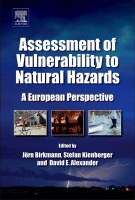Browse content
Table of contents
Actions for selected chapters
- Full text access
- Book chapterAbstract only
Chapter 1 - Theoretical and Conceptual Framework for the Assessment of Vulnerability to Natural Hazards and Climate Change in Europe: The MOVE Framework
Jörn Birkmann, Omar D. Cardona, ... Torsten Welle
Pages 1-19 - Book chapterAbstract only
Chapter 2 - Holistic Evaluation of Seismic Risk in Barcelona
Martha Liliana Carreño, Alex H. Barbat, ... Mabel C. Marulanda
Pages 21-52 - Book chapterAbstract only
Chapter 3 - Spatial and Holistic Assessment of Social, Economic, and Environmental Vulnerability to Floods—Lessons from the Salzach River Basin, Austria
Stefan Kienberger, Diana Contreras and Peter Zeil
Pages 53-73 - Book chapterAbstract only
Chapter 4 - Vulnerability to Earthquakes and Floods of the Healthcare System in Florence, Italy
Roberto Miniati and Christian Iasio
Pages 75-89 - Book chapterAbstract only
Chapter 5 - Vulnerability Assessment to Heat Waves, Floods, and Earthquakes Using the MOVE Framework: Test Case Cologne, Germany
Torsten Welle, Yaella Depietri, ... Stefan Greiving
Pages 91-124 - Book chapterAbstract only
Chapter 6 - Vulnerability to Drought and Heatwave in London: Revealing Institutionally Configured Risk
Zehra Zaidi and Mark Pelling
Pages 125-148 - Book chapterAbstract only
Chapter 7 - Comprehensive Vulnerability Assessment of Forest Fires and Coastal Erosion: Evidences from Case-Study Analysis in Portugal
Fantina Tedim, Manuel Garcin, ... Jeremy Rohmer
Pages 149-177 - Book chapterAbstract only
Chapter 8 - Vulnerability to Heat Waves, Floods, and Landslides in Mountainous Terrain: Test Cases in South Tyrol
Maria Papathoma-Köhle, Thorsten Ulbrich, ... Unni Eidswig
Pages 179-201 - Book chapterAbstract only
Chapter 9 - Conclusion: Assessing Vulnerability in Europe and the World
David E. Alexander
Pages 203-214 - Book chapterNo access
Index
Pages 215-219
About the book
Description
Assessment of Vulnerability to Natural Hazards covers the vulnerability of human and environmental systems to climate change and eight natural hazards: earthquakes, floods, landslides, avalanches, forest fires, drought, coastal erosion, and heat waves.
This book is an important contribution to the field, clarifying terms and investigating the nature of vulnerability to hazards in general and in various specific European contexts. In addition, this book helps improve understanding of vulnerability and gives thorough methodologies for investigating situations in which people and their environments are vulnerable to hazards. With case studies taken from across Europe, the underlying theoretical frame is transferrable to other geographical contexts, making the content relevant worldwide.
Assessment of Vulnerability to Natural Hazards covers the vulnerability of human and environmental systems to climate change and eight natural hazards: earthquakes, floods, landslides, avalanches, forest fires, drought, coastal erosion, and heat waves.
This book is an important contribution to the field, clarifying terms and investigating the nature of vulnerability to hazards in general and in various specific European contexts. In addition, this book helps improve understanding of vulnerability and gives thorough methodologies for investigating situations in which people and their environments are vulnerable to hazards. With case studies taken from across Europe, the underlying theoretical frame is transferrable to other geographical contexts, making the content relevant worldwide.
Key Features
- Provides a framework of theory and methodology designed to help researchers and practitioners understand the phenomenon of vulnerability to natural hazards and disasters and to climate change
- Contains case studies that illustrate how to apply the methodology in different ways to diverse hazards in varied settings (rural, urban, coastal, mountain, and more)
- Describes how to validate the results of methodology application in different situations and how to respond to the needs of diverse groups of stakeholders represented by the public and private sectors, civil society, researchers, and academics
- Provides a framework of theory and methodology designed to help researchers and practitioners understand the phenomenon of vulnerability to natural hazards and disasters and to climate change
- Contains case studies that illustrate how to apply the methodology in different ways to diverse hazards in varied settings (rural, urban, coastal, mountain, and more)
- Describes how to validate the results of methodology application in different situations and how to respond to the needs of diverse groups of stakeholders represented by the public and private sectors, civil society, researchers, and academics
Details
ISBN
978-0-12-410528-7
Language
English
Published
2014
Copyright
Copyright © 2014 Elsevier Inc. All rights reserved.
Imprint
Elsevier
